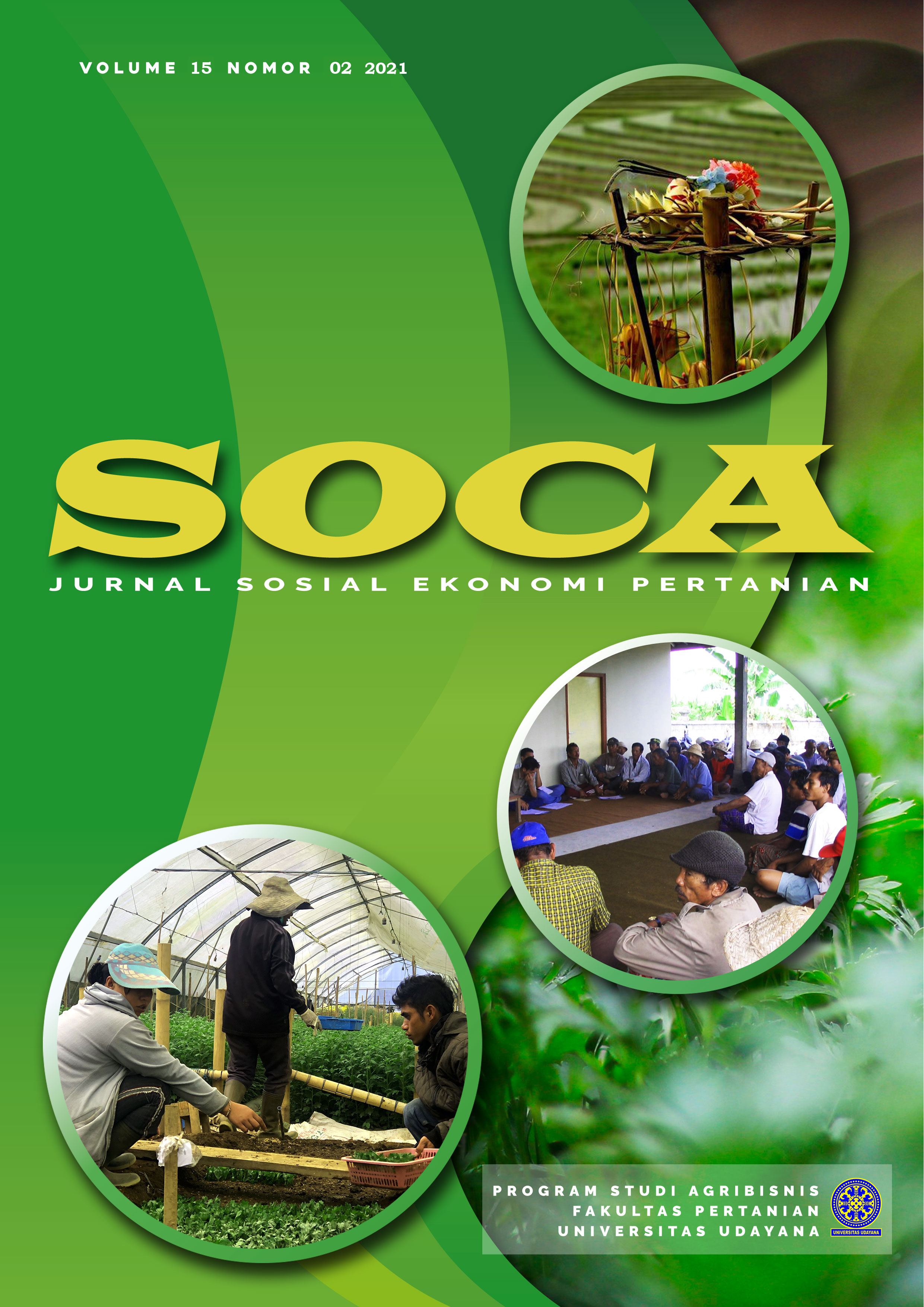The Food Security Of The Household Recipient Of Food Independent Village Program In Central Sumba Regency
Abstract
The Food Independent Village Program was performed to give an impact on reducing the level of food and nutrition insecurity of the needy in rural areas. The success of program implementation can be seen from the level of food security of the household recipients. This research aimed to determine the level of food security based on 1) Share of Food Expenses (PPP), 2) Energy Sufficiency Rate (AKE), 3) Performance of household food security. The research method used was a survey method. Sampling used was a random sample (Random Sampling) with 85 respondents. The analysis method used was a cross-combination approach between the share of food expenses (PPP) and the level of household energy consumption (AKE). The results showed that based on AKE the distribution of food-secure households was 65.53% and food insecure was 36.47%. Meanwhile, based on PPP, the distribution of households that were food insecure was 40% and food secure was 60%. The performance of household food security in the food security category was 25.88 percent, food vulnerability was 40.00 percent, food shortage was 14.12 percent, and food insecurity was 20.00 percent. The proportion of households that were food insecure was still large, which means that efforts were needed to improve the food security of households who were the Food Independent Village program recipients.
Downloads
References
BKP. (2006). Pedoman Umum Desa Mandiri Pangan 2006. Jakarta: Badan Ketahanan Pangan, Departemen Pertanian RI.
BKP. (2018). Peta Ketahanan dan Kerentanan Pangan (Food Security and Vulnerability Atlas) 2018. Jakarta: Badan Ketahanan Pangan Kementerian Pertanian RI.
Dirhamsyah, T., Mulyo, J. H., Darwanto, D. H., dan Hartono, S. (2016). Ketahanan Pangan: Kemandirian Pangan dan Kesejahteraan Masyarakat Daerah Rawan Pangan di Jawa (Cetakan Pe). Yogyakarta: plantaxia.
DKP. (2016). Laporan Tahunan Perkembangan Program Desa Mandiri Pangan (DMP) Kabupaten Sumba Tengah Tahun 2016. Retrieved from waibakul:
Ilham Nyak, B. M. S. (2007). Penggunaan Pangsa Pengeluaran Pangan Sebagai Indikator Komposit Ketahanan Pangan. SOCA, Jurnal Sosial Ekonomi Pertanian Dan Agribisnis, 7 (3), 1–22. Retrieved from ojs.unud.ac.id/index.php/soca/article/.../4217/3200
January, I. (2014). Tingkat Ketahanan Pangan Rumah Tangga Petani dan Pengaruh Kebijakan Raskin. Jurnal Ekonomi Pembangunan, 15 (2), 109–116.
Maxwell, D. C. L. M. A. K. M. R. S. M. and C. A. (2000). ”Urban Livelihoods and Food Nutrition Security in Greater Accra, Ghana”. Washington, D.C.: IFPRI in Collaborative with Noguchi Memorial for Medical Research and World Health Organization. Research Resport No. 112.
Maxwell, S., & R. Frankernberger, T. (1992). Household Food Security: Concepts, Indicators, Measurements. Techinical Review.
Mulyo, J. H., Sugiyarto., dan Widada, A. W. (2015). Ketahanan dan Kemandirian Pangan Rumah Tangga Tani Daerah Marginal di Kabupaten Bojonegoro. Agro Ekonomi, 26 No, 121–128.
Purwaningsih, Y., Hartono, S., Masyhuri, M., & Mulyo, J. H. (2010). Pola Pengeluaran Pangan Rumah Tangga Menurut Tingkat Ketahanan Pangan di Provinsi Jawa Tengah. Jurnal Ekonomi Pembangunan, 11 (2), 236–253. Retrieved from https://doi.org/10.23917/jep.v11i2.327
Purwantini, T. B., Rachman, H. P. S., & Marisa, Y. (2002). Analisis ketahanan pangan tingkat rumah tangga dan regional ( Studi Kasus di Provinsi Sulawesi Utara ). Buletin Agro Ekonomi, 49–69. Retrieved from https://pse.litbang.pertanian.go.id/ind/pdffiles/monograph_26_2005_5.pdf
Rahayu, W. (2010). Ketahanan Pangan Rumah Tangga Miskin di Kabupaten Sukoharjo. AGRIC, Vol.22, No, 67–74.
Riduwan. (2014). Metode dan Teknik Menyusun Proposal Penelitian (untuk Mahasiswa S1, S2 dan S3). Bandung: ALFABETA.
Saliem, H. P., Sumaryanto, Hardono, G. S., Mayrowani, H., P, Tri B., Marisa, Y., dan Hidayat, D. (2006). Diversifikasi Usaha Rumah Tangga Dalam Mendukung Ketahanan Pangan dan Penanggulangan Kemiskinan di Indonesia. Pusat Analisis Sosial Ekonomi dan Kebijakan Pertanian Departemen Pertanian.
Sayogyo. (1991). Household Food Security Indonesian Food Journal. Indonesian Food Journal, 2 (4), 21–31.
Suhardjo. (1996). Pengertian dan Kerangka Pikir Ketahanan Pangan Rumah Tangga. Makalah disampaikan pada Lokakarya Ketahanan Pangan Rumah Tangga, 20 - 30 Mei 1996 Yogyakarta. Yogyakarta.
Suharyanto. (2015). Karakteristik Tingkat Ketahanan Pangan Rumah Tangga Petani Berbasis Agroekosistem Lahan Sawah Irigasi di Provinsi Bali. SEPA, 11 (2), 191–199.













